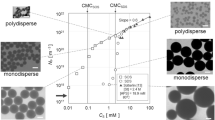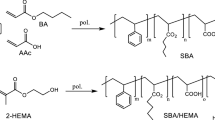Abstract
In this study, formulation of latex with methyl methacrylate (MMA) as a function of surfactant concentration ([S]) under critical micelle concentration (CMC) was investigated to explore the nucleation mechanism and the key to control the particle number (N p) of latex in emulsion polymerization. Influences of surfactant concentration [S] on the conversion of monomer, particle size (PS), N p, and surfactant surface coverage (θ) were studied, as well. Flocculation nucleation was considered as the main mechanism to generate particle nuclei when [S] was much less than CMC. The nucleation mechanism experienced an evolution of a flocculation nucleation-dominated region ([S] < 3.3 mmol L−1) to a micellar nucleation-dominated region ([S] > 3.3 mmol L−1). The contribution ratio of the flocculation nucleation was 86 % compared with the micellar nucleation. The particle number (N p) was found to be controlled by the combination of micellar and flocculation nucleation-dominated regions under CMC, and the regulation range was about 1–6. The results can be used to guide the preparation of a bimodal high solid content (HSC) latex by creating a population of small particles in the presence of an initial population of larger ones in a controllable way. In this way, a controllable amount of large latex particles were prepared using a high emulsifier concentration, at first, and then the second population of small particles was formulated by secondary nucleation at a proper time through controlling surfactant concentration at a low level, followed by the growth of the two groups of the particles, and then the bimodal HSC latex can be prepared at low viscosity.







Similar content being viewed by others
References
Chern CS (2006) Emulsion polymerization mechanisms and kinetics. Prog Polym Sci 31:443–486
Thickett SC, Gilbert RG (2007) Emulsion polymerization: state of the art in kinetics and mechanisms. Polymer 48:6965–6991
Harkins WD (1947) A general theory of the mechanism of emulsion polymerization. J Am Chem Soc 69:1428–1444
Smith WV, Ewart RH (1948) Kinetics of emulsion polymerization. J Chem Phys 16:592–599
Smith WV (1948) The kinetics of styrene emulsion polymerization. J Am Chem Soc 67:3695–3702
Hansen FK, Ugelstad J (1978) Particle nucleation in emulsion polymerization. I. A theory for homogeneous nucleation. J Polym Sci Pol Chem 16:1953–1979
Dobrowolska ME, van Esch JH, Koper GJM (2013) Direct visualization of “coagulative nucleation” in surfactant-free emulsion polymerization. Langmuir 29:11724–11729
Dobrowolska ME, Koper GJM (2014) Optimal ionic strength for nonionically initiated polymerization. Soft Matter 10:1151–1154
Ugelstad J, El-Aasser MS, Vanderhoff JW (1973) Emulsion polymerization: initiation of polymerization in monomer droplets. J Polym Sci Pol Lett 11:503–513
Asua JM (2014) Challenges for industrialization of miniemulsion polymerization. Prog Polym Sci 39:1797–1826
Fitch RM, Tsai CH (1971) Homogeneous nucleation of polymer colloids. IV. The role of soluble oligomeric radicals. In: Fitch RM (ed) polymer colloids. Plenum Press, New York, pp 103–116
Fitch RM, Tsai CH (1970) Polymer colloids: particle formation in nonmicellar systems. J Polym Sci Pol Lett 8:703–710
Capek I, Chern CS (2001) Radical polymerization in direct miniemulsion systems. Adv Polym Sci 155:101–165
Chern CS, Lin CH (1998) Using a water-insoluble dye to probe the particle nucleation loci in styrene emulsion polymerization. Polymer 40:139–147
Chern CS, Lin CH (2000) Particle nucleation loci in emulsion polymerization of methyl methacrylate. Polymer 41:4473–4481
De La Rosa LV, Sudol ED, El-Aasser MS, Klein A (1999) Emulsion polymerization of styrene using reaction calorimeter. III. Effect of initial monomer/water ratio. J Polym Sci Pol Chem 37:4073–4089
Tauer K, Deckwer R, Kühn I, Schellenberg C (1999) A comprehensive experimental study of surfactant-free emulsion polymerization of styrene. Colloid Polym Sci 277:607–626
Yan C, Cheng S, Feng L (2000) Kinetics and mechanism of emulsifier-free emulsion copolymerization: styrene–methyl methacrylate–acrylic acid. J Polym Sci Pol Chem 37:2649–2656
Zhang SF, He YF, Wang RM, Wu ZM, Song PF (2013) Preparation of emulsifier-free acrylate cross-linkable copolymer emulsion and application in coatings for controlling indoor humidity. Iran Polym J 22:447–456
Wang YM, Pan CY (1999) Study of the mechanism of the emulsifier free emulsion polymerization of the styrene/4-vinylpyridine system. Colloid Polym Sci 277:658–665
Ou JL, Yang JK, Chen H (2001) Styrene/potassium persulfate/water systems: effects of hydrophilic comonomers and solvent additives on the nucleation mechanism and the particle size. Eur Polym J 37:789–799
Aylward GH, Findlay TJV (2007) SI chemical data book, 6th edn. Wiley, Hoboken
Blackly DC (1975) Emulsion polymerization: theory and practice. Applied Science Publishers, London
Maxwell IA, Morrison BR, Napper DH, Gilbert RG (1991) Entry of free radicals into latex particles in emulsion polymerization. Macromolecules 24:1629–1640
Guyto A, Chu F, Schneider M, Graillat C, McKenna TF (2002) High solid content latexes. Prog Polym Sci 27:1573–1615
Mariz IFA, Leiza JR, de la Cal JC (2011) Competitive particle growth: a tool to control the particle size distribution for the synthesis of high solids content low viscosity latexes. Chem Eng J 168:938–946
Acknowledgments
The financial supports from the National Natural Science Foundation of China (51163009 and 21466016) were appreciated.
Author information
Authors and Affiliations
Corresponding authors
Rights and permissions
About this article
Cite this article
He, Y., Sun, Y., Zhu, L. et al. A study on the nucleation mechanisms under critical micelle concentration (CMC) in emulsion polymerization of methyl methacrylate (MMA). Iran Polym J 24, 935–944 (2015). https://doi.org/10.1007/s13726-015-0381-9
Received:
Accepted:
Published:
Issue Date:
DOI: https://doi.org/10.1007/s13726-015-0381-9




